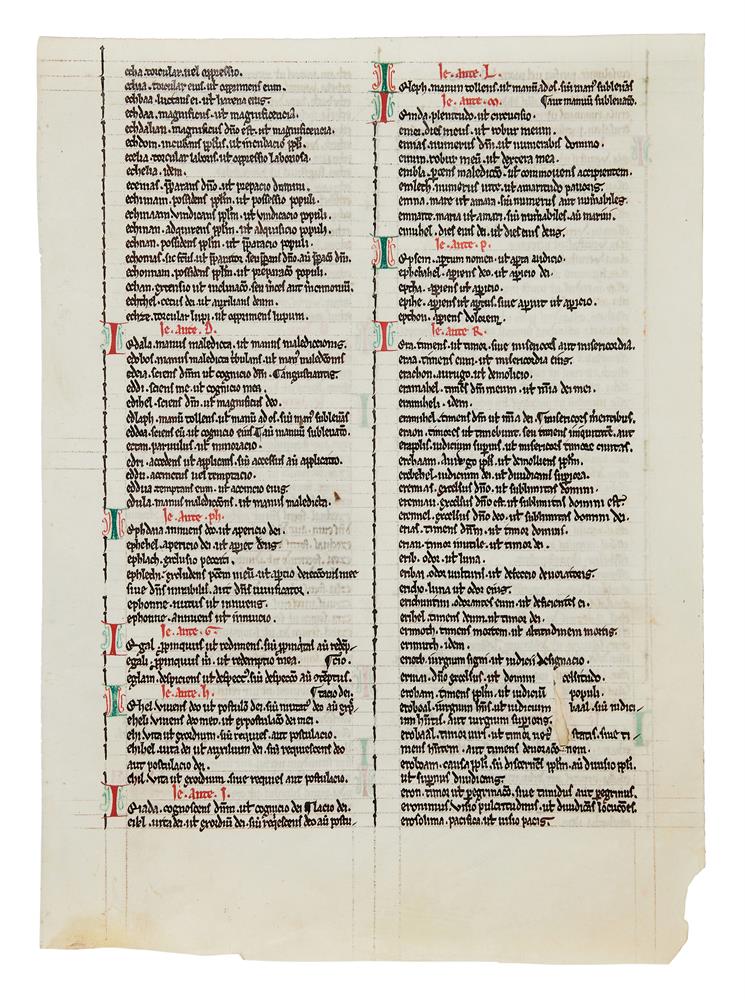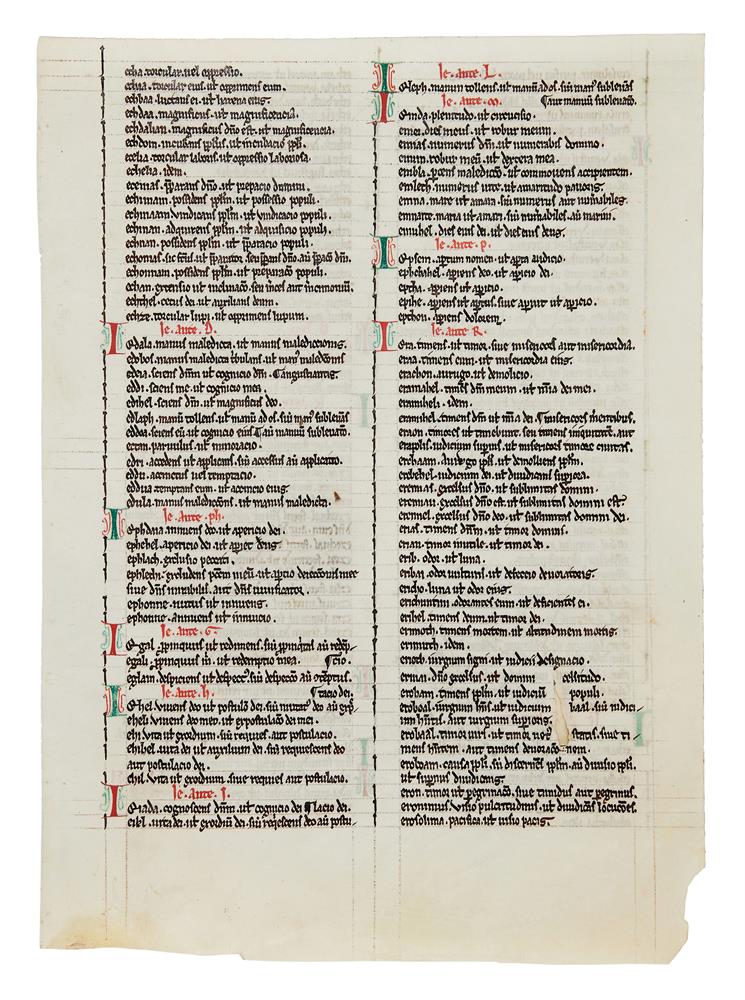BIBLE, with the Interpretation of Hebrew Names, in Latin, DECORATED MANUSCRIPT ON VELLUM
BIBLE, with the Interpretation of Hebrew Names, in Latin, DECORATED MANUSCRIPT ON VELLUM [England, Oxford(?), c.1240] 175 x 120mm. 522 leaves, COMPLETE, collation: 1-6 1 6 , 7 1 4, 8-30 1 6 , 31 1 4 (last two leaves blank), 32 1 6 33 1 4 , ruled in plummet with 48 horizontals, in two columns, justification: 115 x 72mm, written with 47 lines in minute gothic script in dark brown ink, rubrics in red, a FULL-HEIGHT INITIAL PAINTED IN BLUE AND ROSE WITH WHITE ORNAMENT at the start of Genesis, the other biblical books usually with a blue initial six lines high with red penwork, except Psalms 1 (8-line) and 109 (7-line), most of the other ten-part divisions of the Psalms have a similar 5- or 6-line initial, prologues usually with a 5-line initial, Psalms usually with a 2-line initial alternate blue with red penwork or vice versa and verses with alternate blue or red initials, ascenders and descenders of large initials often many times taller than their body (e.g. I Kings, whose initial is 27 lines high including the descender), marginal chapter numbers and running headings in alternate red and blue characters, chapter numbers preceded by trailing blue paraph marks, chapters beginning with a blue initial, capital letters of verses stroked in red, psalms numbered in medieval contemporary arabic numerals in red, with plummet guide-numerals and guide-letters, frequent 13th-century marginalia in an English charter-hand (very occasional marginal losses, repairs or stains, f.1 slightly browned with small hole touching text, a few early-17th century marginal pentrials). 19th-century blind-stamped calf over pasteboards (boards and spine detached). PROVENANCE: 1. Written and decorated in England: characteristic English features include the consistent use of blue initials with red penwork (rather than alternating blue or red initials, with penwork of the contrasting colour). A date in the first half of the 13th century is suggested by a feature of scribal practice and layout: in the early 13th century it was normal for the scribe to write the chapters continuously, with the chapter numbers added in the adjacent margins; but by the middle of the century (cf. lot 204), however, it was normal for the scribe to start each chapter on a new line, and for the rubricator to place the chapter numbers within the text in the spaces thus created (see de Hamel, The Book: A History of the Bible, 2001, pp. 124-25, who dates the change-over to c.1240). In the present manuscript the scribe did not start each chapter on a new line until he reached Ecclesiastes 11; from there onwards he left a space for the chapter numbers; the rubricator, however, continued to place them in the margins: this manuscript therefore perfectly illustrates a still-unfamiliar practice in a transitional phase. 2. An origin in Oxford, or at least very early ownership there, is suggested by the early scholarly use of the book: there are frequent marginalia noting textual variants in a cursive English 13th-century (contemporary?) hand, some of which specifically compare the present text to that of the Gloss: next to Leviticus 11:2, for example, the reader notes 'Iste versus non habetur in libris glos.', referring to the fact that a non-canonical verse is present at this point, and next to I Chronicles 18:3, next to the occurrence of the place-name 'Soba', the annotator has written 'vel Suba secundum glo.'. 3. Inscribed in the 16th century 'by me Rob[er]t Empson [?] of' in the margin next to Proverbs 24. 4. Thomas Vowler Short (1790-1872) (on whom see ODNB and lot 205): inscribed 'King William's College Library presented by Bishop Short 1845' and with an ink stamp of 'The Library of King William's College Isle of Man'. CONTENT: The order of biblical books is very similar to that which became standard in Paris during the second quarter of the 13th century, but not identical; the short apocryphal Epistle of the Laodiceans, for example, is omitted. A few of the standard Paris Vulgate pr
BIBLE, with the Interpretation of Hebrew Names, in Latin, DECORATED MANUSCRIPT ON VELLUM
BIBLE, with the Interpretation of Hebrew Names, in Latin, DECORATED MANUSCRIPT ON VELLUM [England, Oxford(?), c.1240] 175 x 120mm. 522 leaves, COMPLETE, collation: 1-6 1 6 , 7 1 4, 8-30 1 6 , 31 1 4 (last two leaves blank), 32 1 6 33 1 4 , ruled in plummet with 48 horizontals, in two columns, justification: 115 x 72mm, written with 47 lines in minute gothic script in dark brown ink, rubrics in red, a FULL-HEIGHT INITIAL PAINTED IN BLUE AND ROSE WITH WHITE ORNAMENT at the start of Genesis, the other biblical books usually with a blue initial six lines high with red penwork, except Psalms 1 (8-line) and 109 (7-line), most of the other ten-part divisions of the Psalms have a similar 5- or 6-line initial, prologues usually with a 5-line initial, Psalms usually with a 2-line initial alternate blue with red penwork or vice versa and verses with alternate blue or red initials, ascenders and descenders of large initials often many times taller than their body (e.g. I Kings, whose initial is 27 lines high including the descender), marginal chapter numbers and running headings in alternate red and blue characters, chapter numbers preceded by trailing blue paraph marks, chapters beginning with a blue initial, capital letters of verses stroked in red, psalms numbered in medieval contemporary arabic numerals in red, with plummet guide-numerals and guide-letters, frequent 13th-century marginalia in an English charter-hand (very occasional marginal losses, repairs or stains, f.1 slightly browned with small hole touching text, a few early-17th century marginal pentrials). 19th-century blind-stamped calf over pasteboards (boards and spine detached). PROVENANCE: 1. Written and decorated in England: characteristic English features include the consistent use of blue initials with red penwork (rather than alternating blue or red initials, with penwork of the contrasting colour). A date in the first half of the 13th century is suggested by a feature of scribal practice and layout: in the early 13th century it was normal for the scribe to write the chapters continuously, with the chapter numbers added in the adjacent margins; but by the middle of the century (cf. lot 204), however, it was normal for the scribe to start each chapter on a new line, and for the rubricator to place the chapter numbers within the text in the spaces thus created (see de Hamel, The Book: A History of the Bible, 2001, pp. 124-25, who dates the change-over to c.1240). In the present manuscript the scribe did not start each chapter on a new line until he reached Ecclesiastes 11; from there onwards he left a space for the chapter numbers; the rubricator, however, continued to place them in the margins: this manuscript therefore perfectly illustrates a still-unfamiliar practice in a transitional phase. 2. An origin in Oxford, or at least very early ownership there, is suggested by the early scholarly use of the book: there are frequent marginalia noting textual variants in a cursive English 13th-century (contemporary?) hand, some of which specifically compare the present text to that of the Gloss: next to Leviticus 11:2, for example, the reader notes 'Iste versus non habetur in libris glos.', referring to the fact that a non-canonical verse is present at this point, and next to I Chronicles 18:3, next to the occurrence of the place-name 'Soba', the annotator has written 'vel Suba secundum glo.'. 3. Inscribed in the 16th century 'by me Rob[er]t Empson [?] of' in the margin next to Proverbs 24. 4. Thomas Vowler Short (1790-1872) (on whom see ODNB and lot 205): inscribed 'King William's College Library presented by Bishop Short 1845' and with an ink stamp of 'The Library of King William's College Isle of Man'. CONTENT: The order of biblical books is very similar to that which became standard in Paris during the second quarter of the 13th century, but not identical; the short apocryphal Epistle of the Laodiceans, for example, is omitted. A few of the standard Paris Vulgate pr















Testen Sie LotSearch und seine Premium-Features 7 Tage - ohne Kosten!
Lassen Sie sich automatisch über neue Objekte in kommenden Auktionen benachrichtigen.
Suchauftrag anlegen